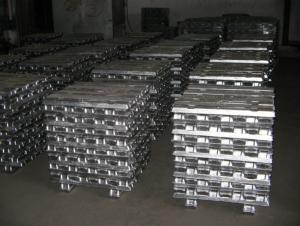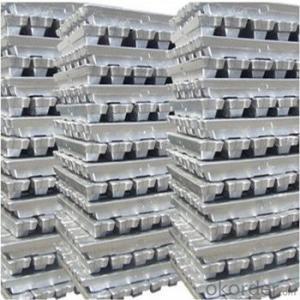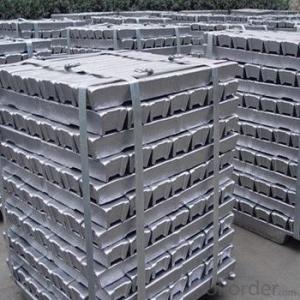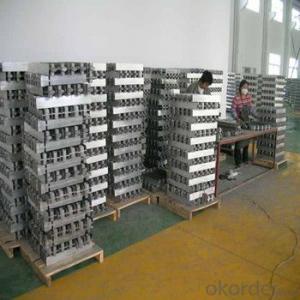Aluminum Pig/Ingot With High Quality From Mills
- Loading Port:
- China main port
- Payment Terms:
- TT OR LC
- Min Order Qty:
- 1000 m.t.
- Supply Capability:
- 100000 m.t./month
OKorder Service Pledge
OKorder Financial Service
You Might Also Like
Pure Aluminum Pig/Ingot Used for Industry
1.Structure of Aluminum Pig/Ingot
A material that has been cast into a shape in order to be transported and processed easier than in an unprocessed form. An ingot is typically rectangular in shape, which allows it to be stacked. Ingots are most commonly associated with metals, with ingots of gold held in the vaults of banks and brokerages being popular images.
Aluminum Ingot is with the AL as the main chemical composition.Aluminum Ingot is used for industry,such as automobile,pinning and weaving,electron broadly and so on. Aluminum Ingot has the following advantages: easy control and operation, fast melting.
2.Main Features of the Aluminum Pig/Ingot
•High Purity
•Easy control and operation
•High strength
•Fast melting
•Competitive price
•Best Service
3.Aluminum Pig/Ingot Images


4.Aluminum Pig/Ingot Specification
Grade | Chemical Composition % | |||||||||
Al≥ | impurities ≤ | |||||||||
Si | Fe | Cu | Ga | Mg | Zn | Mn | others | Sum | ||
Al99.9 | 99.90 | 0.50 | 0.07 | 0.005 | 0.02 | 0.01 | 0.025 | - | 0.010 | 0.10 |
Al99.85 | 99.85 | 0.80 | 0.12 | 0.005 | 0.03 | 0.02 | 0.030 | - | 0.015 | 0.15 |
Al99.7 | 99.70 | 0.10 | 0.20 | 0.010 | 0.03 | 0.02 | 0.030 | - | 0.030 | 0.30 |
Al99.6 | 99.60 | 0.16 | 0.25 | 0.010 | 0.03 | 0.03 | 0.030 | - | 0.030 | 0.40 |
Al99.5 | 99.50 | 0.22 | 0.30 | 0.020 | 0.03 | 0.05 | 0.050 | - | 0.030 | 0.50 |
Al99.00 | 99.00 | 0.42 | 0.50 | 0.020 | 0.03 | 0.05 | 0.050 | - | 0.050 | 1.00 |
5.FAQ of Aluminum Pig/Ingot
We have organized several common questions for our clients,may help you sincerely:
①How about your company?
A professional factory which foucs on producing the aluminum pig,can meet customers' requiement to the quality and grade.The quality also have been accepted by customer.Already got the good reputation among the customers.It have gotten lot of much experience.The facrtory has the professional Technical Worker and the advanced equipments for production.Beside,it has the profesional teams to operate the whole proess for exporting.OEM service is availble and welcome.The items have beedn exported around the world,and have been acceptable among the customers,and have gotten the good reputation already.No matter from the quality,price and service,can be guaranteed for the cusgtomers.High purity and diffent grade are available.
②How to guarantee the quality of the products?
We have established the international advanced quality management system,every link from raw material to final product we have strict quality test;We resolutely put an end to unqualified products flowing into the market. At the same time, we will provide necessary follow-up service assurance.
③How long can we receive the prod rking days, We will arrange the factory delivery as soon as possible. The pecific time of receiving is related to the state and position of customers.Commonly 7 to 10 working days can be served.
- Q: Can aluminum ingots be customized for specific applications?
- Certainly, specific applications can have customized aluminum ingots. Aluminum, a remarkably adaptable metal, can be effortlessly shaped to fulfill diverse needs. Typically, the customization procedure includes combining the aluminum with other elements to amplify qualities like strength, hardness, resistance to corrosion, and thermal conductivity. Furthermore, the ingots can undergo various heat treatment methods such as annealing, quenching, and tempering to further adjust their properties. Consequently, aluminum ingots that are precisely designed for particular applications can be manufactured, encompassing a wide range from automotive parts and aerospace components to construction materials and consumer products.
- Q: What are the common defects found in aluminum ingots?
- Aluminum ingots may exhibit several common defects. Porosity is one such defect, characterized by the presence of small voids or air pockets within the ingot. It can arise from improper casting techniques or insufficient degassing of the molten aluminum. Porosity weakens the overall structure of the ingot and diminishes its mechanical properties. Another defect frequently observed is segregation, which arises when alloying elements or impurities are unevenly distributed within the ingot. This leads to variations in composition and properties across different sections of the ingot. Segregation can be caused by improper alloying or inadequate mixing of the molten aluminum. Cracking is yet another defect often encountered in aluminum ingots. It may occur during cooling or solidification if there is rapid or uneven cooling, resulting in thermal stress and cracking. Excessive hydrogen content in the aluminum can also induce cracking by promoting the formation of internal cracks. Furthermore, surface defects, including dross, oxide films, and inclusions, are commonly found in aluminum ingots. Dross refers to impurities and oxides that float on the surface of the molten aluminum and become trapped in the ingot during solidification. Oxide films form on the ingot's surface due to exposure to air or inadequate protection during casting. Inclusions are foreign particles or non-metallic compounds that get trapped within the ingot during solidification. These defects significantly impact the quality and performance of aluminum ingots. Consequently, it is critical to employ appropriate casting techniques, control alloy composition, ensure sufficient degassing, and implement effective quality control measures to minimize the occurrence of these defects.
- Q: How are aluminum ingots protected from corrosion?
- There are several methods available to protect aluminum ingots from corrosion. One of these is applying a protective coating or film to the surface of the ingots. This coating acts as a barrier, preventing direct contact between the aluminum and the environment and reducing the risk of corrosion. Coatings can include paint, lacquer, or specialized epoxy coatings. Another method is anodization, which involves an electrochemical process that creates a thick oxide layer on the ingots' surface. This oxide layer not only improves the appearance of the ingots but also provides a strong defense against corrosion. Anodization can be done using different techniques, such as sulfuric acid anodizing or chromic acid anodizing, depending on the desired level of protection. In addition, proper storage and handling practices are crucial in protecting aluminum ingots from corrosion. It is important to store the ingots in a dry and well-ventilated area to minimize moisture exposure. They should also be stacked and stored in a way that allows air circulation to prevent the formation of stagnant water or condensation. Regular inspections and maintenance are necessary to detect any signs of corrosion early on and take appropriate action to address it. To sum up, protecting aluminum ingots from corrosion requires a combination of protective coatings, anodization, and proper storage and handling practices. By implementing these measures, the durability and quality of aluminum ingots can be preserved, ensuring their suitability for various applications.
- Q: Brief introduction of die casting aluminium ingot
- Aluminum, our daily industrial raw materials called aluminum ingot, according to the national standard (GB/T1196-93) should be called "remelting with aluminum ingot", but we are used to "aluminum ingot"". It is with the alumina cryolite produced by electrolysis.
- Q: What are the benefits of using aluminum ingots in the construction of lightweight structures?
- Using aluminum ingots in the construction of lightweight structures has several advantages. Firstly, aluminum is a lightweight metal, making it ideal for constructing lightweight structures. Its density is approximately one-third of steel, resulting in significantly lighter structures. This is especially beneficial in industries like aerospace, automotive, and marine, where reducing weight is crucial for enhancing fuel efficiency and overall performance. Secondly, aluminum is highly resistant to corrosion. Unlike other metals, such as steel, aluminum does not rust when exposed to moisture or corrosive elements. This makes it an excellent choice for structures exposed to harsh environmental conditions, like buildings near the coast or in areas with high humidity. By using aluminum ingots, structures can withstand corrosion, ensuring their longevity and reducing maintenance costs. Furthermore, aluminum is a highly malleable material, offering greater design flexibility. It can be easily shaped and formed into complex geometries, enabling architects and engineers to create innovative and aesthetically pleasing structures. This versatility in design also promotes efficient material use, minimizing waste and maximizing the structural integrity of lightweight constructions. Another significant benefit of using aluminum ingots is their excellent strength-to-weight ratio. Despite being lightweight, aluminum structures can still possess impressive strength and durability. This makes them suitable for applications where both strength and weight reduction are essential, such as in aircraft construction, high-rise buildings, and bridges. Additionally, aluminum is a sustainable material due to its high recyclability. It can be melted down and reprocessed repeatedly without losing its properties, making it an environmentally friendly choice. By using aluminum ingots, construction projects can contribute to the circular economy and reduce the demand for new raw materials. In conclusion, incorporating aluminum ingots into the construction of lightweight structures offers numerous benefits. These include reduced weight, corrosion resistance, design flexibility, excellent strength-to-weight ratio, and sustainability. By utilizing aluminum, construction projects can improve performance, enhance efficiency, and minimize environmental impact.
- Q: What are the advantages of using aluminum ingots in the production of consumer electronics?
- There are several advantages of using aluminum ingots in the production of consumer electronics: 1. Lightweight: Aluminum is a lightweight material, making it ideal for consumer electronics where portability is a key consideration. It allows for easier handling and transportation of devices, making them more convenient for consumers to use and carry. 2. Durability: Aluminum is known for its excellent strength-to-weight ratio, which means it can withstand high levels of stress without compromising its structural integrity. This durability ensures that consumer electronics made from aluminum ingots are less prone to breakage or damage, increasing their longevity and reliability. 3. Heat dissipation: Consumer electronics often generate heat during operation, and aluminum's high thermal conductivity helps in dissipating this heat efficiently. This property allows for better heat management, preventing overheating and ensuring the optimal performance of the devices. 4. Corrosion resistance: Aluminum has a natural oxide layer that forms on its surface, providing excellent resistance against corrosion. This makes it suitable for consumer electronics that may be exposed to moisture or humidity, such as smartphones or laptops, as it helps protect the internal components from damage. 5. Aesthetics: Aluminum has a sleek and modern appearance, giving consumer electronics a premium and sophisticated look. Its ability to be easily molded into various shapes and sizes allows for sleek designs that attract consumers who value aesthetics. 6. Eco-friendly: Aluminum is highly recyclable, and using aluminum ingots in the production of consumer electronics promotes sustainability. It reduces the need for extracting and processing raw materials, conserves energy, and minimizes environmental impact compared to other materials like plastic or steel. Overall, the advantages of using aluminum ingots in the production of consumer electronics include lightweight portability, durability, effective heat dissipation, corrosion resistance, attractive aesthetics, and environmental sustainability.
- Q: What are cooked aluminium ingots and aluminium ingots? What specifications do they have?
- Aluminum impurities, hard and brittle nature, touch on the broken, so students cannot use the hammer on aluminum from a variety of activities, can only use sand to cast aluminum utensils, like wash basin, is cast with aluminum liquid.
- Q: How are aluminum ingots alloyed with other metals?
- Aluminum ingots can be alloyed with other metals through various methods. One common method is through the process of melting. Aluminum ingots and the desired alloying metal are melted together at high temperatures, allowing the atoms of the two metals to mix and form a homogeneous mixture. This method is commonly used for alloys with low melting points or when a uniform distribution of the alloying metal is required. Another method is through the process of casting. In this method, molten aluminum is poured into a mold that contains a specific amount of the alloying metal. As the aluminum cools and solidifies, it incorporates the alloying metal into its structure, creating an alloy. This method is often used for alloys that require precise compositions and when a specific shape or form is desired. Furthermore, aluminum ingots can also be alloyed through powder metallurgy. In this process, powdered forms of aluminum and the alloying metal are mixed together thoroughly. The mixture is then compacted under high pressure and heated to a temperature below the melting point of the aluminum. This allows the atoms of the alloying metal to diffuse into the aluminum particles, resulting in a solid-state alloy. Additionally, there are also methods such as electroplating and vapor deposition that can be utilized to alloy aluminum ingots with other metals. These methods involve the deposition of a thin layer of the alloying metal onto the surface of the aluminum ingots through electrochemical or physical processes. Overall, the alloying of aluminum ingots with other metals can be achieved through various techniques, each with its own advantages and applications. The choice of method depends on factors such as the desired composition, the physical properties required, and the specific manufacturing process involved.
- Q: What are the different cutting techniques for aluminum ingots?
- Depending on the desired outcome and specific application, aluminum ingots can be cut using various techniques. These techniques offer different advantages and limitations, making it important to consider factors such as cut quality, speed, shape complexity, and available equipment when choosing a method. One method is bandsaw cutting, which involves using a specialized blade on a bandsaw machine to cut through the ingot. This technique is commonly used for large-scale production due to its high precision and accuracy. Circular saw cutting is another option, where carbide-tipped blades on circular saws are used to cut the ingot. Suitable for both small and large-scale operations, this method offers a relatively fast cutting speed. Waterjet cutting is a technique that utilizes a high-pressure stream of water mixed with an abrasive material to cut through the ingot. Ideal for precise and intricate cuts, this method does not generate heat, minimizing the risk of thermal distortion. Plasma cutting involves melting and cutting the ingot using a plasma torch. This versatile method can be used for various thicknesses and shapes. Laser cutting, on the other hand, utilizes a highly focused laser beam to melt and vaporize the aluminum, resulting in a clean and precise cut. This technique is particularly effective for thin ingots. Shearing is a cutting technique that applies a shearing force to the ingot, typically using a guillotine-style machine. Suitable for cutting thicker ingots, this method can be used for both straight and curved cuts. To determine the most suitable cutting technique for a specific application, it is recommended to consult with experts or professionals in the field.
- Q: How are aluminum ingots used in the marine industry?
- Aluminum ingots are commonly used in the marine industry for manufacturing various components, such as hulls, superstructures, and decks of boats and ships. Aluminum's lightweight and corrosion-resistant properties make it an ideal material for constructing vessels, as it ensures improved fuel efficiency, durability, and longevity. Additionally, aluminum ingots are also utilized in the production of marine equipment, such as propellers, mast structures, and offshore platforms, due to their high strength-to-weight ratio and ability to withstand harsh marine environments.
Send your message to us
Aluminum Pig/Ingot With High Quality From Mills
- Loading Port:
- China main port
- Payment Terms:
- TT OR LC
- Min Order Qty:
- 1000 m.t.
- Supply Capability:
- 100000 m.t./month
OKorder Service Pledge
OKorder Financial Service
Similar products
Hot products
Hot Searches



























